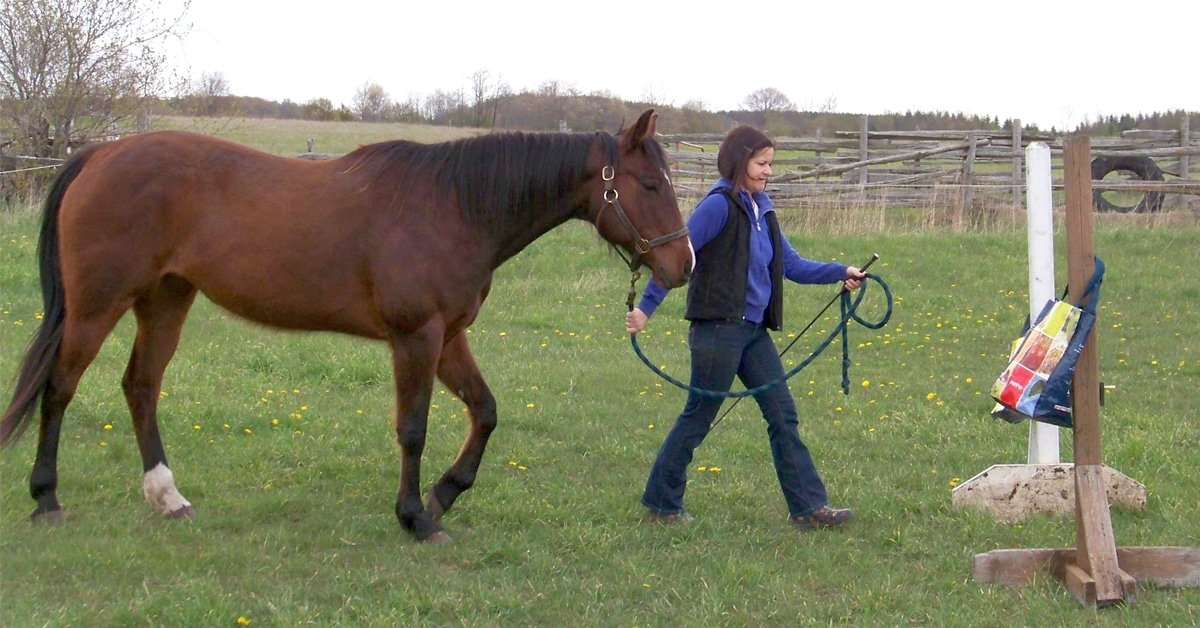As prey animals, horses are instinctively inclined to be afraid of unfamiliar objects, smells, and sounds. And as herd animals, they are naturally fearful when separated from other horses. For our horses’ overall well being, we need to help them to feel safe in situations that are completely unnatural to them.
Because horses communicate with their body language, it’s important that you understand and interpret it appropriately. Unfortunately, the horse’s behaviour is often misinterpreted, not noticed or even ignored. So, the early signs of anxiety or stress are missed or even punished, resulting in an escalation of the behaviour to something more dangerous like bucking, bolting or biting.
Sometimes the horse is labelled as naughty, stubborn, or disrespectful. However, less aggressive behaviours such as planting his feet, turning or backing away, grabbing something with his mouth, and pawing are all signs that he is having a fear response.
No animals (including humans) can learn when in a strong state of anxiety or feeling overwhelmed. Plus, the behaviour of an anxious horse generally results in the handler resorting to firmer or forceful methods which do nothing for building trust or partnership.
With the right training it is possible to override the horse’s natural instincts and help them to become more confident around unfamiliar objects, sounds and situations.
Set Up For Success
To build your horse’s confidence, always set him up for success. Start from the ground before taking the training to the saddle. Break every task down into tiny, simple steps. Every success builds confidence. Pay attention for subtle signs of anxiety so you know when to stop and help your horse to feel safe and relax.
Reward your horse for every small effort he makes, rather than waiting until he has completed the full task. A nice scratch on the withers or neck (as long as he enjoys that) along with a gentle word of praise telling him “yes” is a form of positive reinforcement.
Keep sessions short. Even if you think it hasn’t gone as well as the previous session, just finish with asking your horse to something you know he can do well. Often, processing time is all that is needed; come back to it the following day or week and you might be surprised to see that your horse has connected the dots.
Practice patience. Some horses will respond quickly in one session while others may take weeks or months to make the progress you want to achieve. Allow your horse to investigate and figure things out in their own time. The goal is for your horse to develop curiosity, be interested, and be mentally engaged in whatever you’re doing together.
The most important part to remember when building your horse’s confidence is to avoid taking him over his fear threshold. That is the point where the horse moves from showing attention with no tension (noticing the thing without feeling stressed about it) to showing attention with tension.
Try This at Home
Here is a simple technique for getting your horse closer to scary things without using training methods that actually scare him or cause horses to shut down.

The mare is showing signs of tension as she nears the unfamiliar object. Head elevated. Bending away and trying to move away from it. Stop approaching and lead the horse away.
1. Approach the unfamiliar or scary object or location from a distance. Watch for changes in your horse’s behaviour that show he is aware of the object or location without yet feeling anxious. These behaviours can include raising the head, change of pace (speeding up or slowing down), etc.
2. Stop and wait for small changes in his behaviour that show he is thinking that it’s not a big deal. Behaviours like eyes blinking, head lowering, licking/chewing, shifting attention to something else.
3. Lead him away from the object/location to reinforce that “it’s not a big deal” response.
4. Approach again, watching for the small changes in behaviour that show he is noticing and feeling unsure about the proximity to the object/location. At that moment, stop and wait for the small changes in behaviour that show “it’s no big deal”. Be patient and wait until the horse gives those signals. As soon as that happens, turn away and leave again.
5. Approach again, still allowing the horse to decide how close you get to the object/location.

The mare shows signs of attention to the bag without signs of tension. Reward her and lead her away.
6. Repeat the previous steps until your horse seems to be really okay and curious about the object/location (opening photo). Only then allow him to move forward and check it out. Be careful of not doing this too soon, as you want to avoid the horse touching an object and scaring himself. Be prepared to leave if that happens, but preferably before it happens.
7. Lead your horse away from the object/location when his curiosity is peaking. This really builds confidence and curiosity.
Your horse’s confidence will improve through patient, unhurried, systematic training. The changes may not come overnight, but the end result will be well worth the effort.

